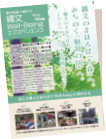Movie
You can listen to the audio from the QR code
You can listen to the audio from the
On July 27, 2021 (Reiwa 3), the Jomon ruins in Hokkaido and northern Tohoku were registered as one of the World Cultural Heritage Sites.
Its value has been recognized due to its abundant nature filled with a variety of blessings that have been maintained and passed down for over 10,000 years through the people’s gathering, fishing, and hunting lifestyle. Not only were the lifestyles of the settlers demonstrated here, the spiritual side of their culture was also depicted and contributed to their values being recognized.
From the stone circles and clay figurines found in Jomon ruins, the development of the people's spiritual culture can be seen. Their heartfelt respect towards their ancestors and nature, and their prayers for fertile crop harvest stand out.
The Jomon period is a period unique to Japan, being that it corresponds with the Paleolithic, Neolithic, and part of the Bronze Age in world history. Japan’s Jomon period began well over 8,000 years earlier than the Chinese and Mesopotamian civilizations that appear in world history.
Jomon pottery excavated from the Omori Shell Midden in Tokyo was discovered to have had rope designs pressed into it giving it the name Jomon (Jo meaning rope) style pottery. This was the origin of the name ''Jomon period.''
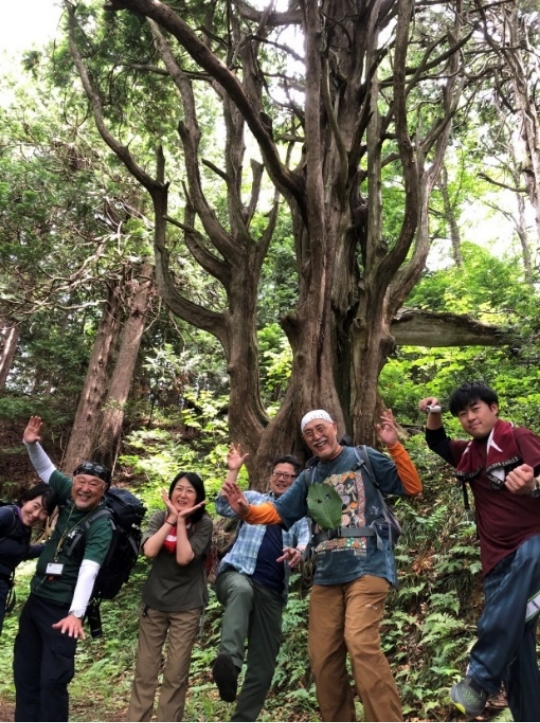
Jomon pit dwellings are made by digging a circular or square pit in the ground, then structuring multiple pillars into the pit, and connecting them with beams and rafters to create the frame of the house.Then the roof is covered with soil, reeds, and other plants.
It is believed that the Jomon people lived in ``pit dwellings,'' which had hearths and fire pits. It is also said that there were food storage areas and graves near the dwellings. By digging approximately 50 cm into the ground, they created a basement like environment, which allowed the humidity to stay at the same level year round.
By lighting a fire over the furnace, it exterminated insects and prevented the wood and thatch from rotting. Pit dwellings were built by making good use of the principles of nature.
In Kanagi Genki Village, it is called a Jomon pit-style dwelling, but because the hole is not dug vertically, it is called Jomon pit-style dwelling with “風” in the name meaning ”style or inspired by” in this context.
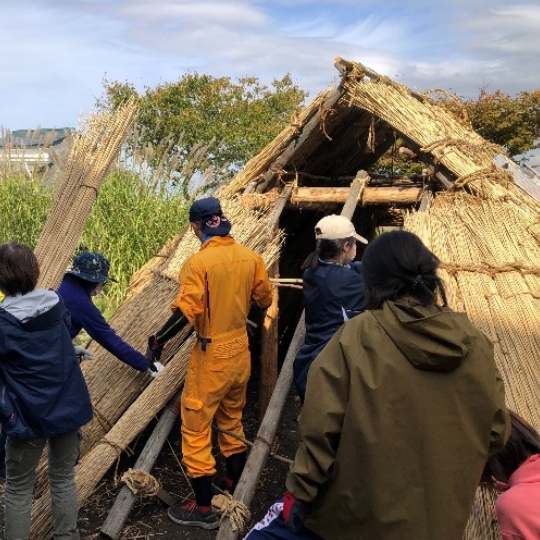
We created Jomon cuisine under the supervision of Sachiko Seo, a culinary researcher who has won two Recipe Awards and is well-knowledged in Jomon culture. With the use of Jomon pottery, we have created a lineup of Jomon cuisine that utilizes cooking methods from open fire to boiling, as well as ingredients that have existed in this area.
Dishes such as sea soup made with seafood stewed in salt, meat wrapped in large leaves and steamed using a baking stone then served with sauce made from mountain fruits, salmon and scallops smoked in Jomon pit dwellings, and dishes created with the ingredients foraged from the mountains Such as mushroom pots can be enjoyed. Additionally, sweets made with chestnuts, walnuts, acorns, and honey can also be enjoyed.
Please enjoy the Jomon rich dining set up created by expanding the imagination.
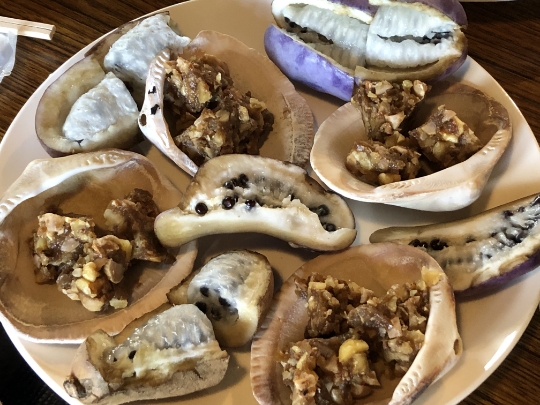
Jomon was a time where no written language existed.
Now we are in an era in which we can use scientific research to imagine and enjoy the worldviews they would have experienced then. The average lifespan of the Jomon people is said to be 30 years, and with recent research it is theorized to be 50 years.
Now we are said to live in a “life goes on til 100” era, but perhaps the Jomon people enjoyed their 50 year lifespan more wholeheartedly than modern people.
Even with the people’s daily lives being at the mercy of various natural phenomena, their smile-filled life can be imagined. Precisely because they have taken a positive view of ''living together with love for nature,'' there may have been a Well-Being lifestyle that the modern world can use as a reference.
It was a time when there were no wars, when children with disabilities were raised with care, and when people were kind to everyone.
Although it cannot be said that the lives of the Jomon people were stress-free, it is imaginable that they had a well rounded life with a well-balanced, positive, and comfortable living.
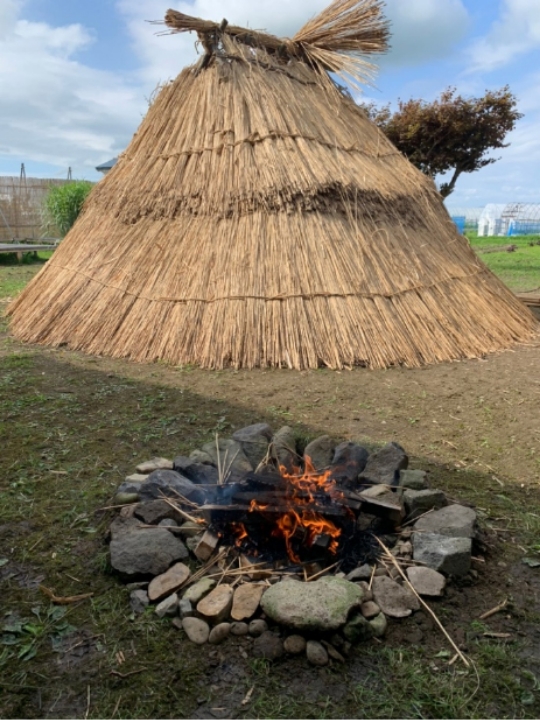
Delusion1
Living in the comfortable rhythm of nature
The Jomon were adept at using flames and enjoyed a creative and colorful lifestyle.The flame, which was at the center of their lives, led the Jomon to a well being. The rhythms of continuity and spontaneity had a calming effect on the mind. They were constantly in touch with the 1/f fluctuation in nature.
Delusion2
Living in harmony with nature and in a regular rhythm
The Jomon people had a clear on and off routine, so their lives had a good balance of the autonomic nervous system. One of the German health-building therapies is called Kneipp therapy. People are born withnatural healing power and enhance the immune system.
Delusion3
Balanced diet and exercise
The Jomon did not live a life of idleness, but ran around in search of foodstuffs. Chestnuts, whose production has been confirmed at archaeological sites, are a representative source of energy for the Jomon. High in carbohydrates, vitamins B and C, and other nutritious ingredients, they were a staple food. Jomon earthenware decorated their dining tables, and they enjoyed a delicious lifestyle.
Delusion4
Touching Aomori hiba
It is said that the ancestors of Aomori hiba were born about a million years ago. The Jomon period may have been a virgin forest of "Aomori hiba". Aomori hiba's four benefits include "antibacterial effect," "tranquilizing effect," "sterilizing effect," and "deodorizing effect. These effects may have been a major factor in fostering the Jomon Well-Being.
Michinoku = 「Land of Charm」 where you will encounter Jomon's 「Mahoroba」 through the ages. By realizing the charm of Jomon and experiencing the spirit and pride of this land, you will be guided to a state of well-being. Let us give you the time to experience the Jomon Mahoroba!
"Mahoroba" is a word that appears in Japan's oldest book, the Kojiki, and means "a wonderful place surrounded by hills and mountains, full of fertility." Even in the Jomon period, which is much older than the Kojiki, there was no written language, but the Jomon people may have used these words to talk about the place where they lived.
Because the Jomon people were already engaged in exchange and trade and had an eye on the outside world, they may have taken pride in their clear location.
The living spaces of the Jomon people who lived in Aomori would have been so uneven that the term ``mahoroba'' would be appropriate.
Experience+Stay
Oku Tsugaru Jomon style overnight plan
2 days and 1 night
(Spring / Autumn)
We will first renovate the holes created in the roofs of the Jomon pit-style dwellings using straw. Then we will ride our mountain bikes into the Aomori Hiba Forest (that has been around since the Jomon Period), then harvest mountain produce, gather around a bonfire, and cook with ingredients used in the Jomon period. Two days of actually having fun and experiencing Jomon style. Imagine a life of harmony with nature in the Jomon period, experience a lifestyle & adventure where you can feel the sunlight filtering through the forest leaves and cool water. Jomon seasonal cuisines are prepared under the supervision of the aforementioned Ms. Seo. The fresh greenery and the autumn leaves are beautiful.
Plan Price (per person):Adult (20 years or older) ¥55,000
〇Min. # of Participants:4 people
〇What's included:• Jomon pit-style dwelling renovation experience fee • Jomon Shinryin-Yoku (fresh greenery) ride experience fee • Jomon cooking experience • accommodation fee • insurance fee • one breakfast meal • 2 lunch meals • 1 dinner meal • interpreter guide
〇Supported Languages:Accompanying English or Chinese staff will be available for an additional fee. (prices vary depending on number of people, content, etc)
Course Details
First day
at 9:00 am meet at Kanagi Genki-mura. Orientation ~ 9:30am Genki-mura (bike) ~ Jomon Shinrin-Yoku (fresh greenery) ride (bike) ~ rural scenery ~ Oku Tsugaru Trail, Osamu Dazai Yurkari no Chi with course Forest Road (bike) (Shinrin Tetsudo (railway) remains ~ Fuji no taki ~ Yu no Sawa ፠ Along the way, we harvest the bounty of the mountains.) ~ Jomon bento in Yu no Sawa ~ rural scenery ~ Ashino Park Station ~ Shopping at Nakaya Supermarket ~ 1600 Kanagi Genki-mura (commemorative photo) ~ then Jomon Ryuri no Yube (cuisine) experience ~ stay (please also enjoy BAR Jomon)
Second day
breakfast ~ 9:00am orientation ~ Jomon pit-style dwelling renovations (includes stuffing straw into the gaps created in the roofs) experience ~ 12:00 Jomon bento ~ Jomon pit-style dwelling prep (renovation experience as mentioned above) x Agricultural products harvest experience (schedule) ~ 14:30 Take a commemorative photo wearing Jomon clothes ~ end.

Oku Tsugaru Jomon style overnight plan 2 days and 1 night (Spring / Autumn)
Experience+Stay
Oku Tsugaru Jomon style overnight plan
2 days and 1 night
(Winter)
During the Jomon period, Oku Tsugaru is said to have been warmer than it is today, but there still must have been cold winter days. Walking through the Aomori Hiba forest which has been around since the Jomon period, experience the beauty and charm that can only be experienced in the harsh winter by walking through the thick snow in traditional snowshoes. Sit around a bonfire, and enjoy the cooking that uses ingredients known from the Jomon period. Using the previously mentioned activities, enjoy the 2 day experience of Jomon. Imagining the harsh winters during the Jomon period, we have prepared an experience that can only be enjoyed due to these hard conditions. With a replication of their lifestyle and adventures, we offer you the joyous moments of the Jomon period. Meals will be served with seasonal winter cuisine inspired by the Jomon period, supervised by Ms. Sachiko Seo.
Plan Price (per person):Adult (20 years or older) ¥55,000
〇Min. # of Participants:2 people
〇What's included:• ・Jomon Winter Wonderland stroll fee・become encapsulate by light wisps of Jomon snow・Jomon Ryori experience (cuisine)・accomodation fee・insurance fee・1 breakfast meal・2 lunch meals・ 1 dinner meal・interpreter guide
〇Supported Languages:Accompanying English or Chinese staff will be available for an additional fee. (prices vary depending on number of people, content, etc)
Course Details
First day
9:00 am Meet at Kanagi Genki-mura. Orientation ~ 9:30am Genki-mura (bike) ~ Jomon winter forest snowshoe experience (on foot) ~ oku Tsugaru Trail Kamiki Junihon Yase Course ~ Jomon bento at Junihon Yasu ~ Junihon Yasu Forest Road exit (train) ~ 1600 Kanagi Genki-mura (commemorative photo) ~ then Jomon Ryuri no Yube (cuisine) experience ~ stay (please also enjoy BAR Jomon)
Second day
breakfast ~ 9:00am orientation (bike) become encapsulate by light wisps of Jomon snow ~ 12:00 Jomon lunch (Shayokan Yonekura) ~ winter agricultural processing activities experience (schedule) ~ 14:30 take a commemorative photo wearing Jomon clothes ~ end (train)
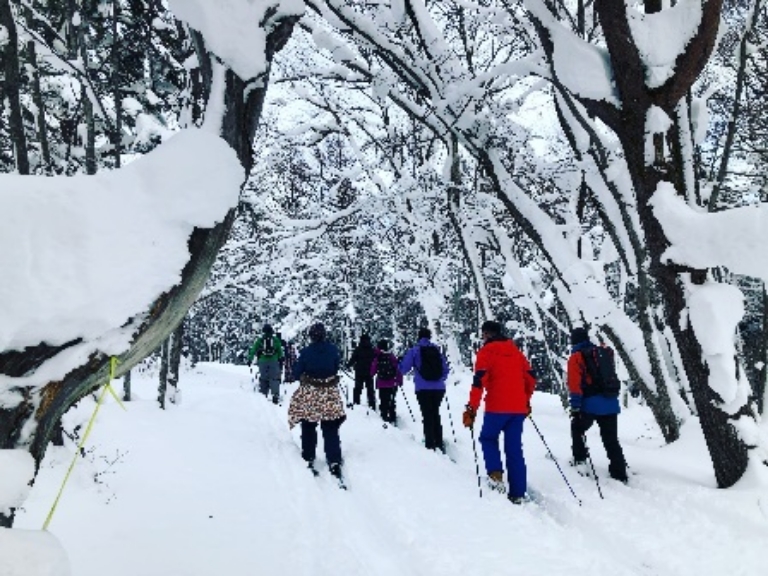
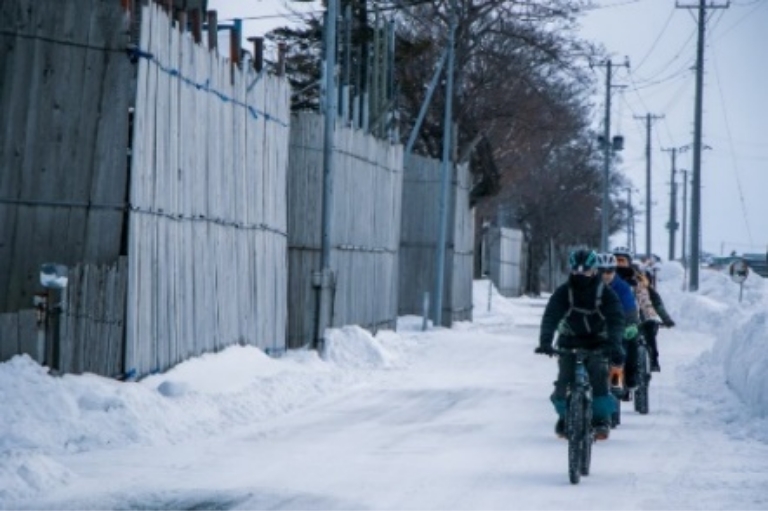
Oku Tsugaru Jomon style overnight plan 2 days and 1 night (Winter)
Experience+Stay
Sannai Maruyama ruins and Jomon village life experience【Okutsugaru edition】
The Jomon period, which lasted 12,000 years, was a time of well-being.In addition to a guided tour of the Sannai-Maruyama ruins, this stay plan combines programs such as making Jomon pottery reminiscent of the Jomon period in the field of Tsugaru, eating Jomon cuisine, experiencing Jomon pit-style house renovation, and a Jomon adventure ride.This stay plan allows you to experience the well-being of the Jomon period, which began to form villages. It's not just a tour of the ruins, it's a chance to relive and experience the romantic lifestyle of the Jomon “Mahoroba”.
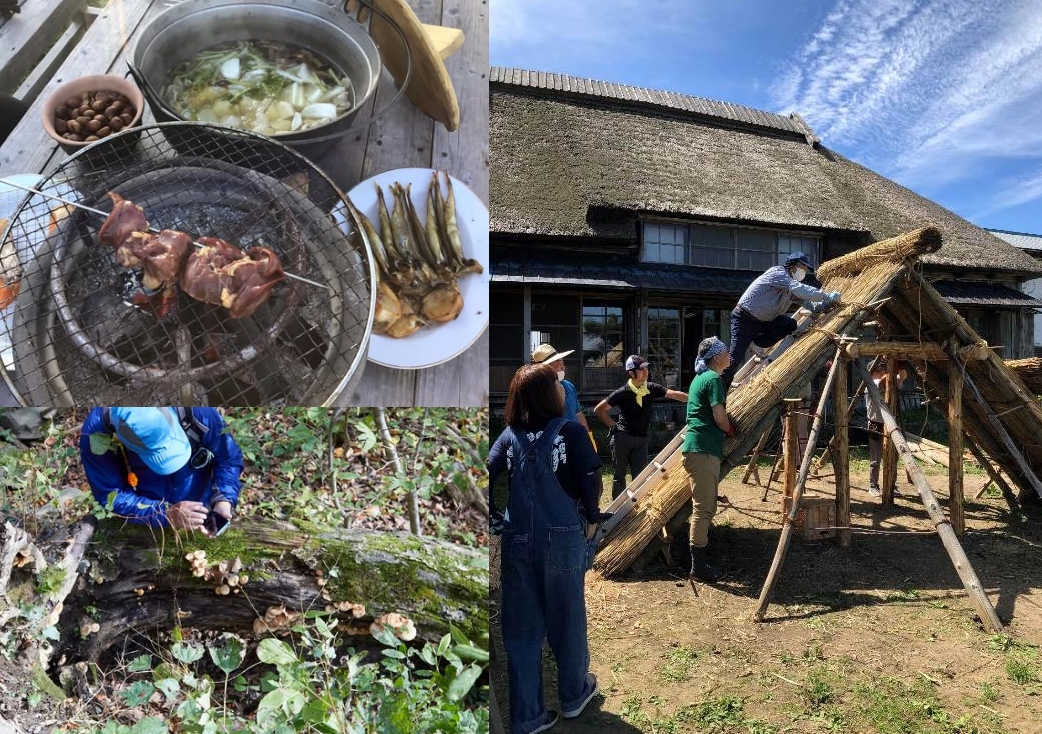
Plan Price (per person):Adult (20 years or older) ¥49,500
〇Date of operation: Spring Golden Week to late November ※Excluding Thursdays.
〇Minimum number of participants: 4 people
〇Included in the price: Sannai Maruyama ruins entrance fee, Jomon pottery making experience, Jomon pit-style house construction experience fee, Jomon forest bathing walk experience fee, Jomon cooking experience, accommodation fee, insurance fee, consumption tax, 1 breakfast, 2 lunches, 1 dinner, round-trip transportation from Shin-Aomori Station from meeting to dissolution.
〇 Guide support: English interpreter staff (separate fee, consultation required), Chinese interpreter staff (separate fee, consultation required)
Course Details
First day
10:00 Meet at Shin-Aomori Station or Aomori Station →(Drive)→ To Sannai Maruyama Ruins ~ 10:30 Sannai Maruyama Ruins Historic Site Guide (A volunteer guide will guide you around the Sannai Maruyama Ruins. ~ 12:00 Lunch (Jomon Lunch) →(Drive)→Go to Tsugaru Kamegaoka ware "Shikiroan" ~ 13:30 "Jomon earthenware making experience" ~ 15:30 Go to old folk house Kanagaki Genki Village →(Drive)→ 16:00 “Jomon cooking experience” at old folk house Kanagi Genki Village ※Bathing etc. ~ 18:00 “Jomon cuisine evening” ~ 20:00 Kanagi Genki Village or Inagaki Onsen (Overnight stay)
Second day
8:00 Breakfast ~ (※Inagaki Onsen →(Drive)→To the old folk house Kanagi Genki Village) ~ 9:00 Orientation ~ “Jomon pit style house renovation experience” at the old folk house Kanagi Genki Village ~ 11:40 Lunch (Kanagi Genki Village) ~ 12:30 Jomon adventure ride or forest bathing walk ~ 15:30 Reflection at the old folk house Kanagi Genki Village ~ To Shin-Aomori Station or Aomori Station →(Drive)→ Shin-Aomori Station or Aomori Station Dismissal

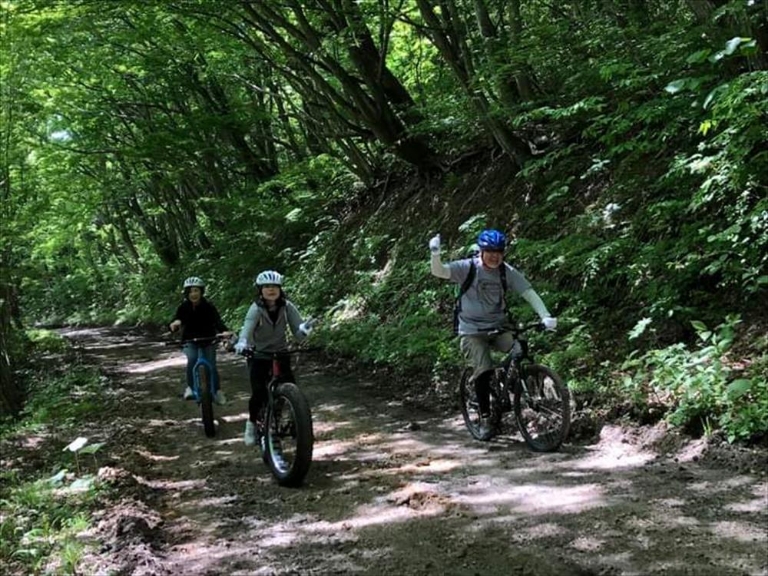
Sannai Maruyama ruins and Jomon village life experience【Okutsugaru edition】
Experience+Stay
Futsumori Shell Midden and Jomon Village “Resurrection Supplement” Experience【Shimokita edition】
The Jomon period was a time of well-being, and using the world heritage site “Nimori Shell Mound” as a gateway, we will travel back in time to the “Mahoroba” of the Jomon period, which also spread to the Shimokita Peninsula. A forest bathing walk while enjoying the nature of the Yagen Valley, which continues from the Jomon period, a relaxing time at Yagen Onsen and Shimofuro Onsen, and food and sweets inspired by the Jomon period will lead to well-being. The “Resurrection Supplement”, which was taken even in the Jomon period, makes the mind and body feel better.
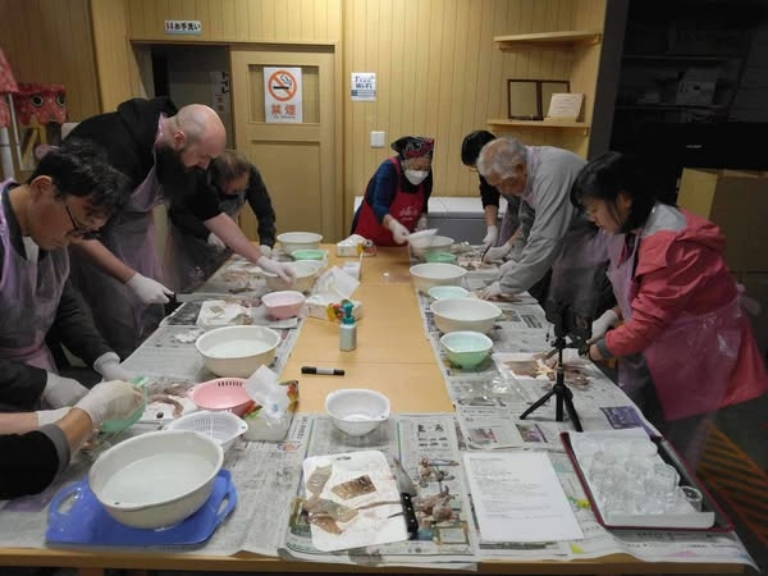
Plan Price (per person):Adult (20 years or older) ¥66,000
〇Date of operation: Spring Golden Week to late November ※Excluding Thursdays.
〇Minimum number of participants: 4 people
〇Included in the price: Entrance fee to Futsumori Shell Midden, salted squid making experience (Jomon cooking experience),
Jomon forest bathing walk experience fee, accommodation fee (double room), insurance premium, consumption tax, 1 breakfast, 2 lunches, 1 dinner, round-trip transportation from Shin-Shichinohe Towada Station from meeting to dissolution.
〇 Guide support: English interpreter staff (separate fee, consultation required), Chinese interpreter staff (separate fee, consultation required)
Course Details
First day
10:00 Gather at Shichinohe-Towada Station →(Drive)→ Go to Futsumori Kaizuka ~ 10:30 Guide by Nitsumori Kaizuka curator →(Drive)→ Go to Roadside Station Lake Ogawara ~ 12:00 Lunch (fresh clam dishes, etc.) ~ 13:00 Go to Yokohama Roadside Station “Nanana Plaza” ~ 14:00 →(Drive)→Go to Mutsu City Ohata Community Center via Roadside Station Yokohama “Nanana Plaza”→(Drive)→~15:00 Visit the clay figurines and clay surfaces of the Futsubashi Ruins at the Ohata Community Center in Mutsu City ~ Go to Kazamaura Fishing Port →(Drive)→ 15:30 “Jomon salted fish making experience” at the squid storage center ~ 16:30 Stroll around Shimofuro hot springs ~ Kaikyo no Yu ~ 18:30 “Shimokita Peninsula's delicious meal” ~ 20:00 Free time/sleep
Second day
8:00 Breakfast ~ 9:00 Shimofuro Onsen →(Drive)→ To Yagen Onsenkyo ~ 9:30 Orientation ~ Oku Yagen Kappa no Yu "Jomon Revival Supplement Walk" ~ 12:00 Lunch (Sakura Trout Bowl & Jomon Sweets) ~ 12:45 Kappa no Yu Bath ~ 13:30 To Shichinohe-Towada Station →(Drive)→15:30 Disband at Shichinohe-Towada Station
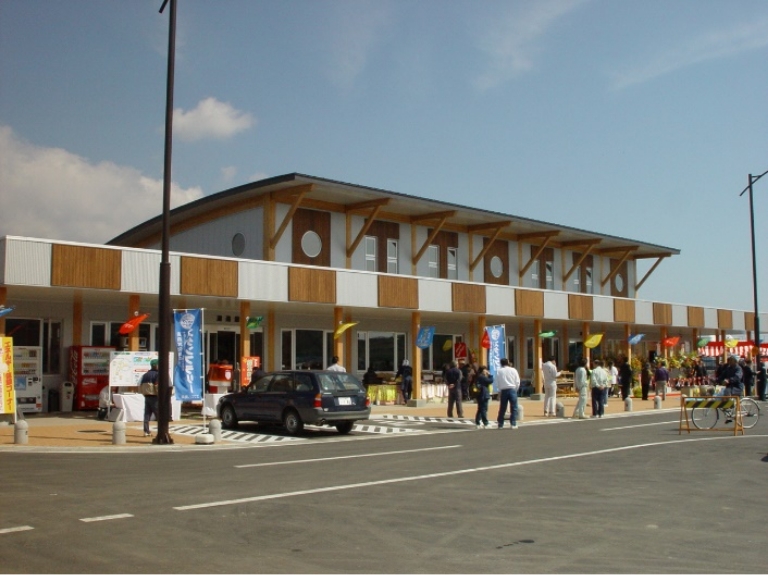
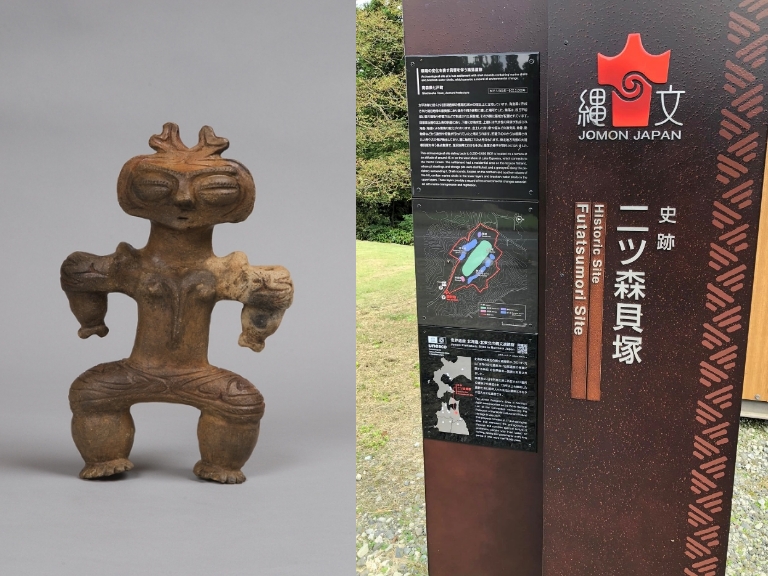
Futsumori Shell Midden and Jomon Village “Resurrection Supplement” Experience【Shimokita edition】
Experience
Yagen Onsenkyo “Jomon Revival Supplement Walk” Experience
Forest therapy in Yagen Onsen Village, which is also part of the Shimokita Geopark, walking through Japan's three most beautiful forests, Aomori Hibarin, and Yagen Stream, hot spring therapy using Yagen Onsen, a well-balanced lunch with plenty of seafood from the Tsugaru Strait, and rope therapy. A comforting experience that uses Jomon sweets made with nuts that have been eaten since the Mon era to provide “revitalizing supplements that have been passed down since the Jomon period” that lead to well-being that incorporates the three essentials of health: exercise, nutrition, and rest.
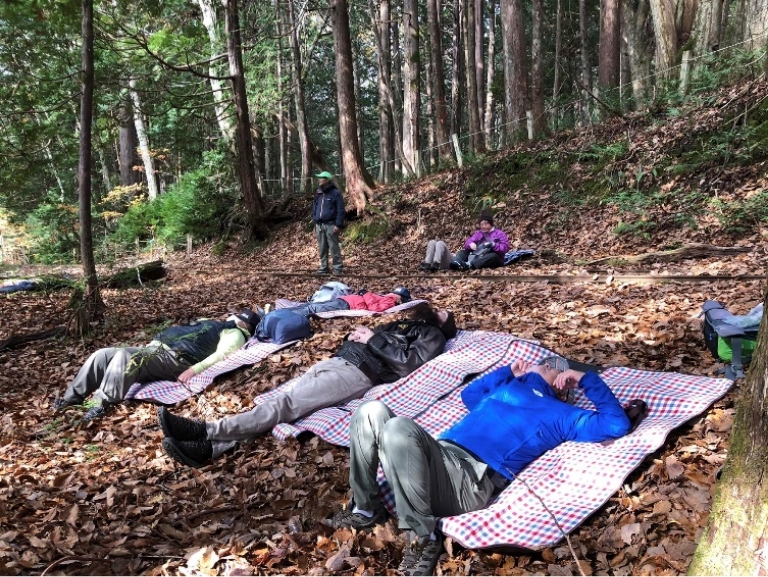
Plan Price(per person) / ¥6,600
〇Date:Spring Golden Week to late November ※Excluding Thursdays.
〇Minimum number of participants: 2 people
〇 Price includes: Jomon forest bathing walk therapy guide fee, insurance fee, lunch, sweets fee, consumption tax
〇 Guide support:English interpreter staff (separate fee, consultation required)
Chinese interpreter staff (separate fee, consultation required)
Course Details
10:00-13:30(3.5hours)
10:00 Okuyakuken Kappa no Yu gathering ~ Orientation & warm-up exercises ~ 10:15 Resurrection supplement walk starts ~ Explanation of Aomori Hiba in the Aomori Hiba Experimental Forest ~ Introduction to Aomori Hiba forest and mixed broad-leaved forest, collecting beech nuts ~ 10:30 Stretching in the "Shoborin" pose and taking a commemorative photo at the ruins of the Yagen forest railway track ~ 10:50 Sitting and watching while listening to the murmuring of the Yagen Valley ~ 11:20 Go to the forest railway sulfur tunnel ~ Pitch darkness experience ~ Go back through the tunnel, cross Otome Bridge, walk along the riverbank ~ 11:40 Stretching and commemorative photos ~ 12:00 Lunch (Jomon sweets making experience and cherry salmon bowl ~ 12:45 Relieve fatigue with a footbath ~ 13:00 Dismissal
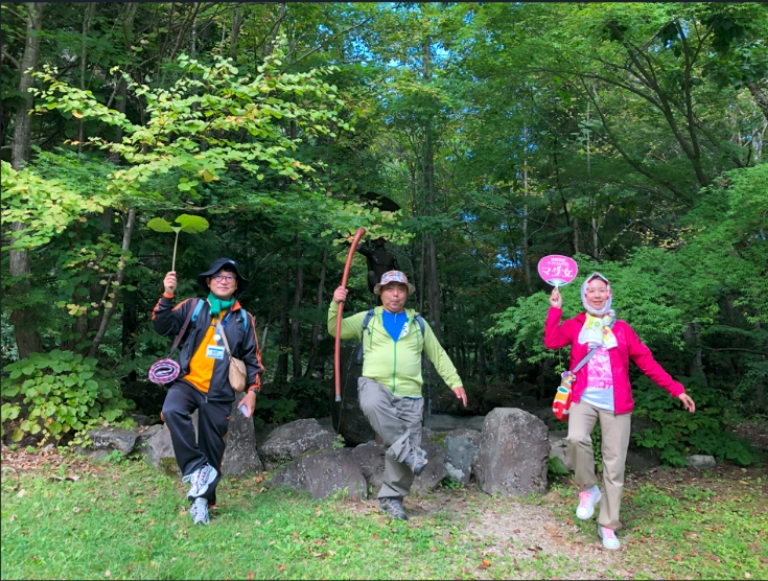
Yagen Onsenkyo “Jomon Revival Supplement Walk” Experience
Experience
Komakino Ruins Jomon Walk Experience
The Komakino ruins, where the story takes place, is one of the Jomon ruins in Hokkaido and northern Tohoku, a world heritage site, and there is a stone circle on a small hill where rituals and festivals are said to have been held. The scenery is also beautiful, overlooking Hakkoda and Mutsu Bay. Using this field, you can enjoy a Nordic walk with wellness in mind while collecting mountain fruits such as nuts and wild plants that are said to have been around since then, and then do yoga in a stone circle, experiencing the scenery of the Jomon period with all five senses.
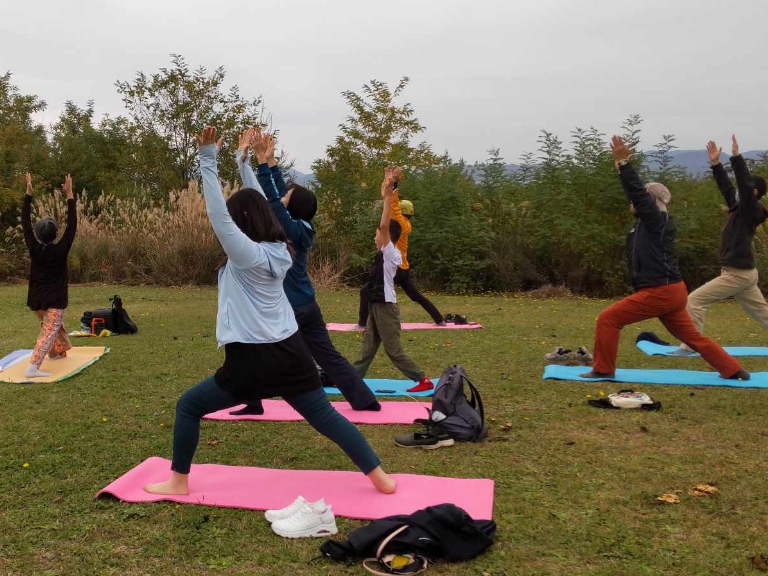
Plan Price(per person)/ ¥6,600
〇Date:Spring Golden Week to late November ※Excluding Thursdays.
〇Minimum number of participants: 4 people
〇What is included in the price:
Komakino Ruins Jomon Walk Therapy guide fee, insurance premium, consumption tax
〇 Guide support:
English interpreter staff (separate fee, consultation required)
Chinese interpreter staff (separate fee, consultation required)
Course Details
10:00-12:00(2hours)
10:00 Komakino Forest/Acorn House gathering ~ Orientation & introduction about the Komakino ruins by a professional guide ~ 10:20 Jomon Nordic Walk starts ~Go to the Komakino Ruins Stone Circle~10:30 Introduction to the stone circle~Go to the observation deck and enjoy the scenery of Aomori City and Hakkoda from a sitting area~Walk around the Komakino Ruins Chestnut Forest~11:10 Return to the stone circle, Stone Circle Yoga~Commemorative photo~11:50 Look back at the Acorn House~Disband
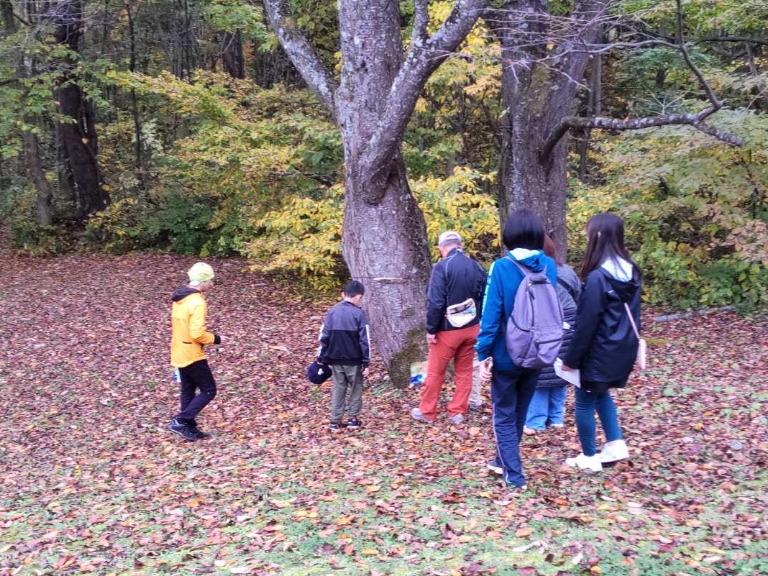
Komakino Ruins Jomon Walk Experience
Experience
【Okutsugaru】Jomon Adventure Ride
An E-MTB course on the Oku-Tsugaru Trail, a forest road with beautiful fresh green leaves in spring and beautiful autumn leaves in fall. With a guide, you can collect wild vegetables, mushrooms, and nuts in the Aomori Hibari forest, one of Japan's three most beautiful forests, while imagining what it would be like to live in harmony with nature in the Jomon period. Experience wellness and adventure by bathing in the sunlight filtering through the forest leaves and improving your blood circulation in the cold springs. The bento boxes offer seasonal Jomon cuisine. We will also introduce you to the remains of the Tsugaru Forest Railway track along the road, which is typical of Oku-Tsugaru, and the setting of the novel by the great writer Osamu Dazai.
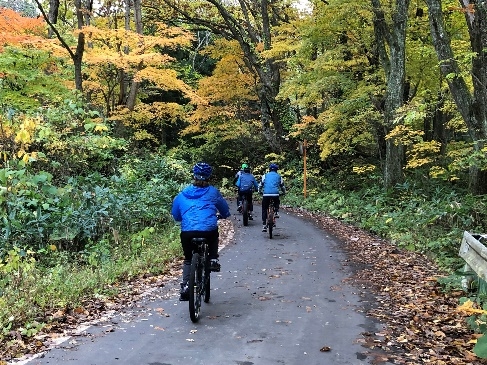
Plan Price(per person) / ¥5,500
※rental bicycle / ¥3,300
〇Date:Spring Golden Week to late November ※Excluding Thursdays.
〇Minimum number of participants: 2 people
〇What is included in the price:
Okutsugaru Adventure Ride guide fee, insurance fee, consumption tax
〇 Guide support:
English interpreter staff (separate fee, consultation required)
Chinese interpreter staff (separate fee, consultation required)
Course Details
10:00-14:30(4.5hours)
9:30 Gather at Kanagi Genki Village ~ 10:00 Orientation ~ 10:20 Adventure Ride Start ~ Ride through the countryside ~ Oku Tsugaru Trail Route related to Osamu Dazai Forest Road (Forest Railway Ruins ~ Fuji Falls ~ Yunosawa) ~ Lunch at Yunosawa ~ Ride through the countryside ~ 14:30 Kanagi Genki Village (commemorative photo) ~ Disband
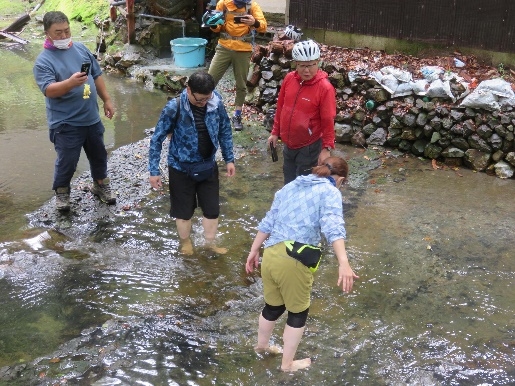
【Okutsugaru】Jomon Adventure Ride
Experience
【Okutsugaru】Jomon Wellness Satoyama Walk
A walking course with a Jomon theme on the Oku Tsugaru Trail “Aomori Hibano Sacred Tree Course”. Just like the Jomon people, you will be guided through Japan's three most beautiful forests, Aomori Hibari, collecting wild vegetables, mushrooms, and nuts, and walking through the greenery, bathed in sunlight filtering through the trees. Travel back in time and come across the remains of the Tsugaru Forest Railway track along the road, the 12 Sacred Trees and the Seven Falls, listen to the rustling of leaves and the murmuring of a mountain stream in a hammock, and feel the 1/F fluctuation. The bento boxes offer seasonal Jomon cuisine.
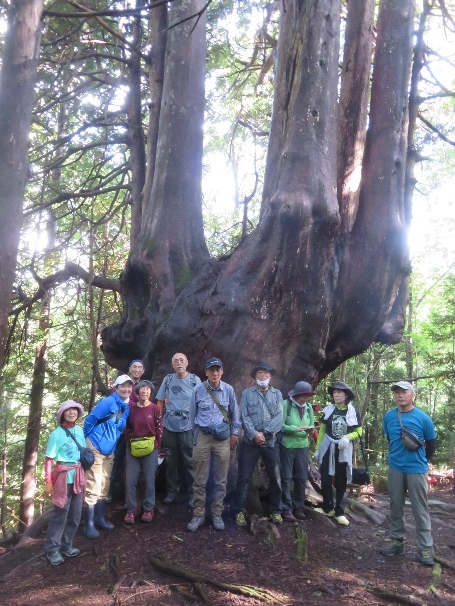
Plan Price(per person)/ ¥6,600
〇Date:Spring Golden Week to late November ※Excluding Thursdays.
〇Minimum number of participants: 2 people
〇What is included in the price:
Okutsugaru Jomon Trail guide fee, insurance fee, consumption tax, taxi fee to the trail course entrance
〇 Guide support:
English interpreter staff (separate fee, consultation required)
Chinese interpreter staff (separate fee, consultation required)
Course Details
9:30-15:00(5.5hours)
9:30 Kanagi Genki Village meeting/orientation ~ 10:15 Kamiki course departure gate ~ Stroll along the Aomori Hiba forest road while collecting wild vegetables, mushrooms, nuts, etc. ~12:00 Seven Falls (lunch) ~1/F Yuragi (hammock) ~Aomori Hiba's twelve sacred trees (stretching experience)~Kneipp therapy in the mountain stream of the forest railway ruins (tunnel)~14:30 Course exit ~15:00 Kanagi Genki Village (commemorative photo) ~Dissolution
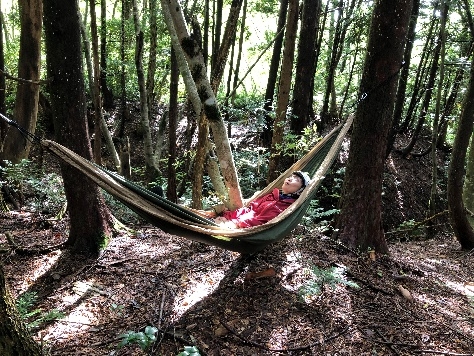
【Okutsugaru】Jomon Wellness Satoyama Walk
Experience
【Okutsugaru】Jomon pit style house construction assembly kit experience
After the orientation, we will hold a course called ``Wellness in the Jomon Period,'' and then, as part of our experience of living in the Jomon period, we will have the opportunity to set up a Jomon pit-style dwelling. We have accumulated experience from 15,000 years ago, and with that knowledge we are recreating the Jomon pit-style dwellings in modern times. In order to make this an experience program where you can set up the building within a certain amount of time, we designed it so that you can assemble it using the panel construction method and use ropes to set it up. A program where you can enjoy the warmth of grass that has been passed down since the Jomon period, and spend some time in Oku-Tsugaru while sitting around a hibachi brazier.

Plan Price(per person) / ¥6,600
〇Date:Spring Golden Week to late November ※Excluding Thursdays.
〇Minimum number of participants: 2 people
〇What is included in the price:
Okutsugaru Jomon Trail guide fee, insurance fee, consumption tax, taxi fee to the trail course entrance
〇 Guide support:
English interpreter staff (separate fee, consultation required)
Chinese interpreter staff (separate fee, consultation required)
Course Details
9:30-15:30(5hours)
9:30Kanagi Genki Village meeting~10:00orientation& Jomon Wellness Course - Setting up a Jomon pit-style dwelling in the garden of Genki Village *Tie the grass panels to pillars (willow vines)~12:00 Lunch at Kanagi Genki Village~13:00 Construction and overall adjustment of the roof of a Jomon pit-style dwelling~15:30 The event ended with a commemorative photo taken wearing Jomon costumes.
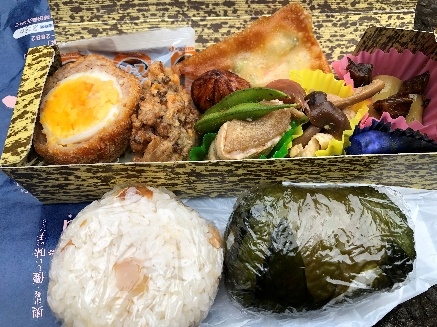
Jomon pit style house construction assembly kit experience
Access
Adress
39-2 Makita Kuwamoto, Kaneki-cho, Goshogawara-shi, Aomori
Approximately 30 minutes on foot from Kanagi Station on the Tsugaru Railway. Since there is no local bus service, we recommend the use of a cab (8 minutes).
80 minutes by car (rental car) from Aomori Airport or Shinkansen Shin-Aomori Station...
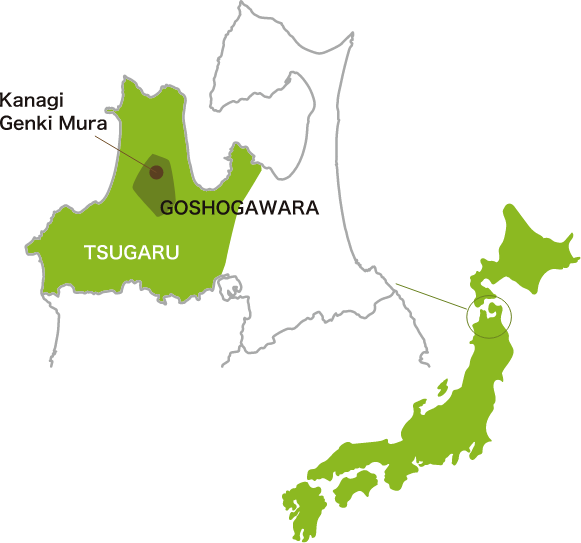
Contact
Inquiries about accommodations
General Incorporated Association Kanagi Genki Mura
Telephone:0173-52-2882
Mobile:080-3324-8792
Email:ito@kanagi-genkimura.org
Inquiries about Travel
Blue Morris Co. Ltd, 4 Ride
Telephone:017-718-8557
Mail:northwind.4ride@gmail.com
(reception time 9:00 ~ 18:00) / [Aomori Prefecture Governor Registered Travel Agency No 2-158






